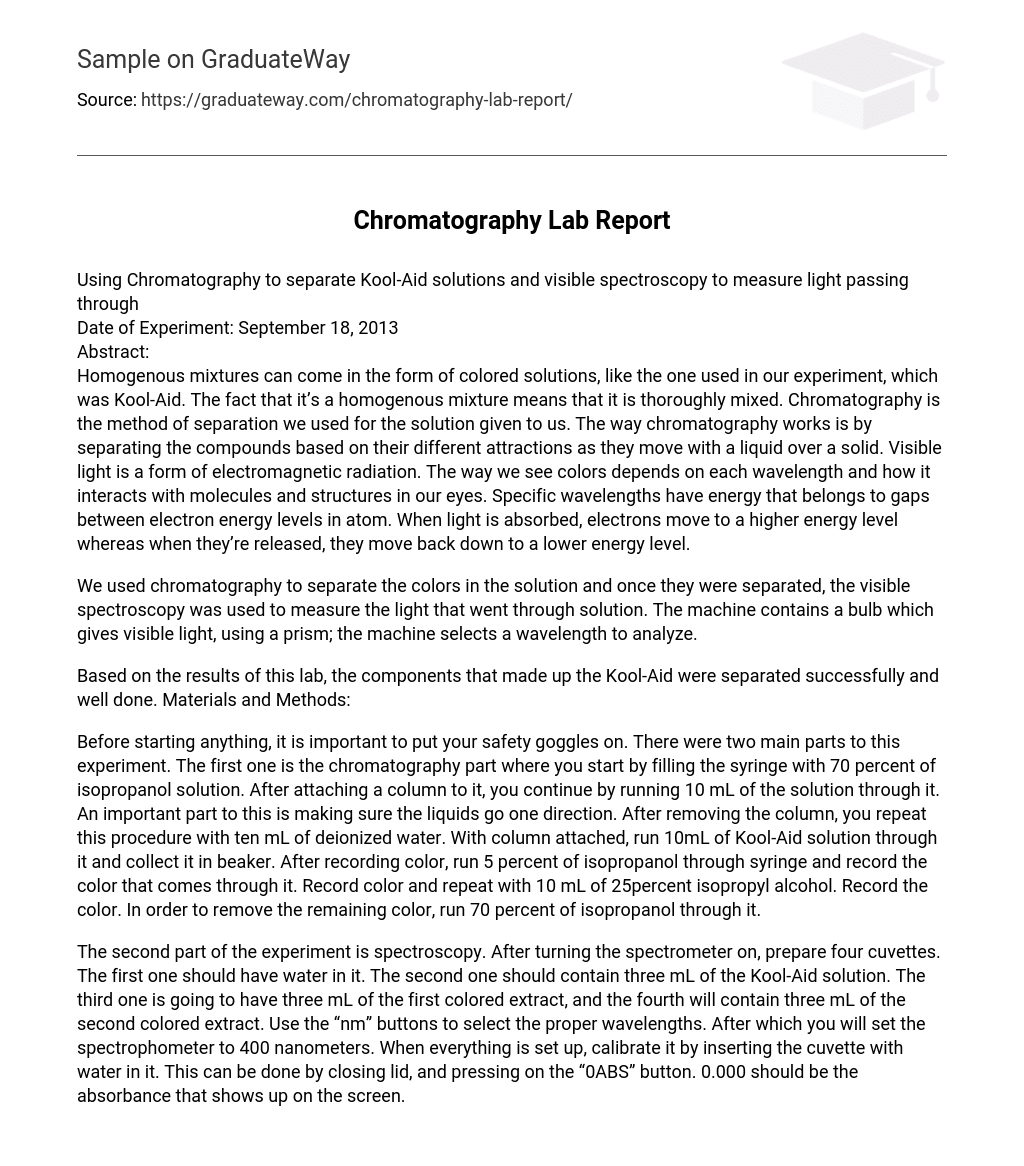Using Chromatography to separate Kool-Aid solutions and visible spectroscopy to measure light passing through
Date of Experiment: September 18, 2013
Abstract:
Homogenous mixtures can come in the form of colored solutions, like the one used in our experiment, which was Kool-Aid. The fact that it’s a homogenous mixture means that it is thoroughly mixed. Chromatography is the method of separation we used for the solution given to us. The way chromatography works is by separating the compounds based on their different attractions as they move with a liquid over a solid. Visible light is a form of electromagnetic radiation. The way we see colors depends on each wavelength and how it interacts with molecules and structures in our eyes. Specific wavelengths have energy that belongs to gaps between electron energy levels in atom. When light is absorbed, electrons move to a higher energy level whereas when they’re released, they move back down to a lower energy level.
We used chromatography to separate the colors in the solution and once they were separated, the visible spectroscopy was used to measure the light that went through solution. The machine contains a bulb which gives visible light, using a prism; the machine selects a wavelength to analyze.
Based on the results of this lab, the components that made up the Kool-Aid were separated successfully and well done. Materials and Methods:
Before starting anything, it is important to put your safety goggles on. There were two main parts to this experiment. The first one is the chromatography part where you start by filling the syringe with 70 percent of isopropanol solution. After attaching a column to it, you continue by running 10 mL of the solution through it. An important part to this is making sure the liquids go one direction. After removing the column, you repeat this procedure with ten mL of deionized water. With column attached, run 10mL of Kool-Aid solution through it and collect it in beaker. After recording color, run 5 percent of isopropanol through syringe and record the color that comes through it. Record color and repeat with 10 mL of 25percent isopropyl alcohol. Record the color. In order to remove the remaining color, run 70 percent of isopropanol through it.
The second part of the experiment is spectroscopy. After turning the spectrometer on, prepare four cuvettes. The first one should have water in it. The second one should contain three mL of the Kool-Aid solution. The third one is going to have three mL of the first colored extract, and the fourth will contain three mL of the second colored extract. Use the “nm” buttons to select the proper wavelengths. After which you will set the spectrophometer to 400 nanometers. When everything is set up, calibrate it by inserting the cuvette with water in it. This can be done by closing lid, and pressing on the “0ABS” button. 0.000 should be the absorbance that shows up on the screen. Measure the absorbance of the first, second, and third solutions afterwards. Calibrate it to zero every time you change the wavelength. Repeat this process at twenty nanometer intervals that start at 400 and end at 700 nanometers.
Results
Part A:
Color of Original SolutionColor of expelled solutions
PurpleLight yellow
ClearPink
PinkViolet/Blue
Part B: Graph
Kool-Aid1 extract2 extract
4000.2910.1120.135
4200.2950.1360.133
4400.2780.1240.21
4600.420.1930.156
4800.6620.3140.224
5000.8160.4090.314
5200.2430.3970.326
5400.6130.3190.306
5600.3330.1310.186
5800.2680.0390.181
6000.3530.030.243
6200.6840.0550.481
6400.6160.0670.474
6600.1650.0210.131
6800.023-0.0040.022
7000.001-0.003-0.005
Part A: Table
Discussion
The separation of colors for the Kool-Aid solution worked very well. It may not have been perfect, and this might have been because of human error, but it the separation of colors was successful. This was indicated by the data we collected after putting the extracts in the spectrometer with the different wavelengths. It can be more clearly seen in the graph however. The graph shows that the first extract was successfully separated from the Kool-Aid solution, the linear graphs for both of them show very different results. However for the second extract, the line is a lot more similar to the Kool-Aid solution which shows that it may not have separated as well as the first extract. However this is only seen in the 640-700 nanometer range of the graph. Before that, the components seem to have been separated decently.
The colors absorbed by the solution relate to the colors of dye components and mixtures observed by showing the complement of the original color. The color absorbed is the exact opposite of the color originally shown by the color of dye components and mixtures. For example, the color originally absorbed (the color of the Kool-Aid), was a blue violet. What was observed was its complement, which was yellow. This is how the color observed and absorbed relates.
The components of Kool-Aid separated at different steps of the experiment because of the different polarity. Different components were absorbed at different rates throughout the lab. The different kinds of chemicals used also factored in on how the components separated at different rates of the experiment. What determines the polarity is if the components of the
solutions were more attracted to liquid or solid parts. Depending on what the preference is, this can cause them to move at different speeds and therefore separate at different steps in the lab.





